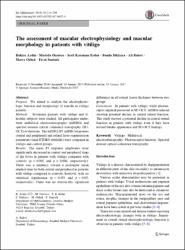| dc.contributor.author | Aydın, Rukiye | |
| dc.contributor.author | Özsütçü, Mustafa | |
| dc.contributor.author | Karaman Erdur, Sevil | |
| dc.contributor.author | Dikkaya, Funda | |
| dc.contributor.author | Balevi, Ali | |
| dc.contributor.author | Özbek, Merve | |
| dc.contributor.author | Şentürk, Fevzi | |
| dc.date.accessioned | 10.07.201910:49:13 | |
| dc.date.accessioned | 2019-07-10T19:50:55Z | |
| dc.date.available | 10.07.201910:49:13 | |
| dc.date.available | 2019-07-10T19:50:55Z | |
| dc.date.issued | 2018 | en_US |
| dc.identifier.citation | Aydın, R., Özsütçü, M., Karaman Erdur, S., Dikkaya, F., Balevi, A., Özbek, M. ve Şentürk, F. (2018). The assessment of macular electrophysiology and macular morphology in patients with vitiligo. International Ophthalmology, 38(1), 233-239. https://dx.doi.org/10.1007/s10792-017-0452-3 | en_US |
| dc.identifier.issn | 0165-5701 | |
| dc.identifier.issn | 1573-2630 | |
| dc.identifier.uri | https://dx.doi.org/10.1007/s10792-017-0452-3 | |
| dc.identifier.uri | https://hdl.handle.net/20.500.12511/2104 | |
| dc.description | WOS: 000428760800034 | en_US |
| dc.description | PubMed ID: 28108905 | en_US |
| dc.description.abstract | Purpose We aimed to analyze the electrophysiologic function and morphology of macula in vitiligo patients. Methods Seventeen patients with vitiligo and 11 healthy subjects were studied. All participants underwent multifocal electroretinography (mfERG) and spectral domain optical coherence tomography (SD-OCT) evaluations. The mfERG (P1 mfERG responses central and peripheral) and retinal layer segmentation parameters (nine ETDRS subfields) were compared in vitiligo and control groups. Results The mean P1 response amplitudes were significantly decreased in central and peripheral rings of the fovea in patients with vitiligo compared with controls (p = 0.002 and p = 0.006, respectively). There was a tendency toward a prolonged mean implicit time for both central and peripheral in patients with vitiligo compared to controls, however, with no statistical significance (p = 0.453 and p = 0.05, respectively). There was no statistically significant difference in all retinal layers thickness between two groups. Conclusion In patients with vitiligo, while photoreceptor segment preserved in SD-OCT, mfERG reduced showing potential decline in central retinal function. This study showed a potential decline in central retinal function in patients with vitiligo even if they have normal fundus appearance and SD-OCT findings. | en_US |
| dc.language.iso | eng | en_US |
| dc.publisher | Springer Netherlands | en_US |
| dc.rights | info:eu-repo/semantics/embargoedAccess | en_US |
| dc.subject | Vitiligo | en_US |
| dc.subject | Multifocal Electroretinography | en_US |
| dc.subject | Photoreceptor Function | en_US |
| dc.subject | Spectral Domain Optical Coherence Tomography | en_US |
| dc.title | The assessment of macular electrophysiology and macular morphology in patients with vitiligo | en_US |
| dc.type | article | en_US |
| dc.relation.ispartof | International Ophthalmology | en_US |
| dc.department | İstanbul Medipol Üniversitesi, Tıp Fakültesi, Cerrahi Tıp Bilimleri Bölümü, Göz Hastalıkları Ana Bilim Dalı | en_US |
| dc.department | İstanbul Medipol Üniversitesi, Tıp Fakültesi, Dahili Tıp Bilimleri Bölümü, Deri ve Zührevi Hastalıklar Ana Bilim Dalı | en_US |
| dc.authorid | 0000-0003-0668-3749 | en_US |
| dc.authorid | 0000-0001-8954-5055 | en_US |
| dc.authorid | 0000-0001-9829-7268 | en_US |
| dc.authorid | 0000-0003-2312-2521 | en_US |
| dc.authorid | 0000-0001-5057-0405 | en_US |
| dc.authorid | 0000-0002-4280-5718 | en_US |
| dc.authorid | 0000-0002-8851-6559 | en_US |
| dc.identifier.volume | 38 | en_US |
| dc.identifier.issue | 1 | en_US |
| dc.identifier.startpage | 233 | en_US |
| dc.identifier.endpage | 239 | en_US |
| dc.relation.publicationcategory | Makale - Uluslararası Hakemli Dergi - Kurum Öğretim Elemanı | en_US |
| dc.identifier.doi | 10.1007/s10792-017-0452-3 | en_US |
| dc.identifier.wosquality | Q3 | en_US |
| dc.identifier.scopusquality | Q2 | en_US |


















